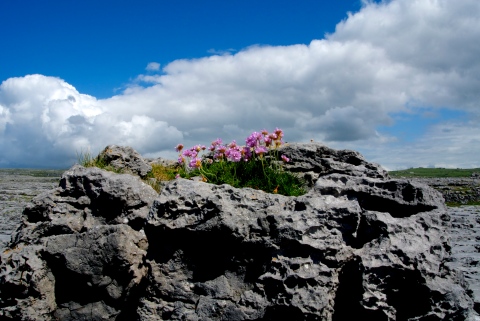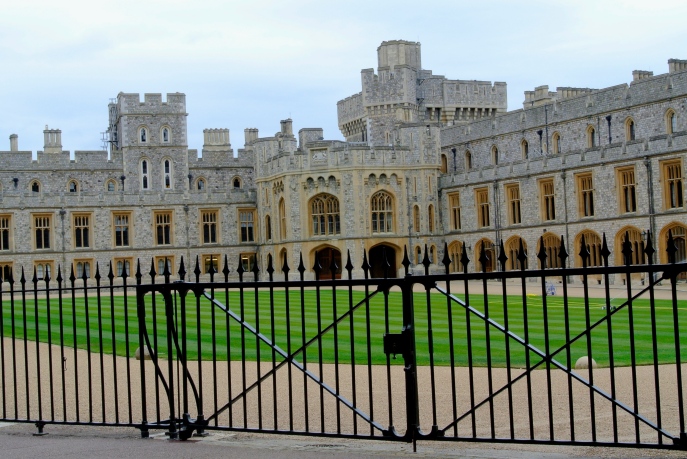Like a couple of old but still valuable coins, my brother and I were collected from our Killarney hotel at 7 a.m. by a man in a van. He drove us to Limerick to meet up with the tour bus. Someone else got the seats in the first row, so we sat on the left in the second row. I know the hung-over man in the front seat appreciated having such a nice view to sleep through on most of the tour. We contented ourselves with seeing what was left.
The Up and Down Castle
Bunratty Castle has experienced a number of ups and downs since 1270 when Robert De Muscegros built the first fortress near the Ratty River. Literal ups and downs. After being raised, razed, and ruined (history’s three R’s) for almost 700 years, Standish Robert Gage Prendergast Vereker took on the daunting task of shortening his name to 7th Viscount Gort. He then restored and refurbished the castle (in 1954) so tourists would have some interesting places to leave their money when visiting Clare County. It worked. Tourists visit Clare County, they leave their money there, and they find it interesting.
As was, is, and ever will be my wont, I gawked a lot. Viscount Gort furnished the castle with medieval furniture and tapestries, and visitors are free to roam about and try to remember to take some pictures. Tapestries from the 15th century and antlers of giant deer decorate the walls of the Great Hall. Giant deer with antlers up to 24 feet wide once roamed the Irish countryside. Thankfully, some of them died in bogs, those Irish scrapbooks of early history. The folks who run Bunratty Castle not only let you photograph whatever you want, but they also have a website that shows the Bunratty collection. How’s that for Irish hospitality?
After visiting the castle we wandered through the folk village on the castle grounds. We didn’t have enough time to see all of the grounds because we needed to head to our next stop.

I never found out what this door was alarmed about. I wasn’t alarmed even once at the Bunratty Folk Village.
“I can resist anything but temptation.”
We stopped in Doolin for lunch at O’Connor’s Pub and stumbled into a chocolate shop nearby called The Chocolate Shop Doolin, makers of Wilde Irish chocolates. I don’t remember much after that. I know money exchanged hands and I was holding a label that said 70% dark chocolate. I remember, too, that the chocolate was organic fair-trade. (As you probably guessed, the chocolate was named in honor of Oscar Wilde who made the famous statement about temptation.)
The Cliffs of Moher
On our last day, the weather turned warm and sunny, mostly. To the southwest, some kind of cloud convention was going on, but they hung around the horizon and didn’t head our way. The bus driver said the tour group on the previous saw little of the Cliffs because of the fog.
When we un-bused, everyone un-sweatered themselves, and headed lemming-like toward the cliffs. In spite of the grand weather, I managed to take quite a few bad pictures, but also captured some with a ridiculously blue sky and sea.
Part of the cliffs were cordoned off to make sure the tourists go over to that part. We made sure to do so ourselves. I made both my camera and purse hold my hand but managed to lose my coral windbreaker, which I had slung over my purse because it was a one-shirt day. Thankfully the windbreaker didn’t jump over the Cliffs; it just jumped down on a walkway to get a closer look. Before we left, I checked the lost and found, and someone had turned it in.
Let’s Rock!
As we headed for Galway to catch our train back to Dublin, we stopped at The Burren, which means “rocky place” in Gaelic. Geologists, scientific Rock Stars, call the limestone landscape ‘karst’: a rocky place full of fissures, cracks, caves, and sinkholes, which sounds remarkably like my brain. Unlike politicians, you can’t find much dirt in the limestone bedrock, yet it hosts over 700 species of plants, both those that grow in arctic and alpine areas of the world and those more typically found in the Mediterranean.
Fairy tree
As our bus hurtled forward to Galway on the motorway, the driver pointed out a fairy tree on our left. He even slowed down a bit and explained that the controversy over moving the fairy tree had delayed the building of the roadway for ten years. In the end, the tree won, the non-fairies rerouted the roadway, and the Irish moved on to other controversies. Since I was sitting on the left, I had a clear shot of the tree, which I didn’t get. I’m still mastering the skills of photography: digging in my bag for the camera, turning on the camera, looking through the viewfinder, seeing total blackness, removing the lens cap, looking through the viewfinder again, and trying to remember how to adjust the f/stop, shutter, aperture, and speed dial. If you want to see the tree of controversy, you have to visit someone else’s blog, someone like Paz, who obviously has mastered that tricky speed dial on his camera.
Back to Dublin
In Galway, my windbreaker, tried of being slung over my purse, left me again, seeking solace in the arms of a stranger. If you happen to be Galway and see someone wearing a coral windbreaker, say hi for me, and tell it I’m sorry.
Thankfully we picked up something to eat on the train because when we got to our downtown Dublin hotel, it was after 9 p.m., and we couldn’t find a place to eat.
Farewell to charms
Like a bowl of Lucky Charms slurped down by an adult who should know better, our time in Ireland was swallowed up by the calendar. My brother left Dublin the next morning to return to Budapest, and I retraced my route via ferry and train back to London to a hotel near Heathrow. The following day I flew back to the States and stepped off the plane into the waiting arms of the TSA, and finally my husband.






















































